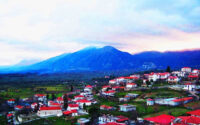 This comprehensive work, “Pellana and Travellers in the Peloponnese,” serves as a valuable resource for researchers, scholars, and enthusiasts seeking to expand their knowledge and understanding of the ancient Spartan settlement of Pellana. The document meticulously compiles and synthesizes a wealth of information from primary sources, scholarly publications, and archival materials to illuminate the rich history and significance of this captivating site. A copy of the EBook may be downloaded via link: PELLANA – TRAVELLERS IN THE PELOPONNESE
This comprehensive work, “Pellana and Travellers in the Peloponnese,” serves as a valuable resource for researchers, scholars, and enthusiasts seeking to expand their knowledge and understanding of the ancient Spartan settlement of Pellana. The document meticulously compiles and synthesizes a wealth of information from primary sources, scholarly publications, and archival materials to illuminate the rich history and significance of this captivating site. A copy of the EBook may be downloaded via link: PELLANA – TRAVELLERS IN THE PELOPONNESE
Situated in the heart of the Peloponnese region of Greece, Pellana has long held a captivating allure for those drawn to the study of ancient Greek history and archaeology. As a prominent Spartan settlement with roots stretching back to the classical era, Pellana has been the subject of intense scholarly exploration, yielding invaluable insights into the dynamics of this remarkable corner of the ancient Greek world.
Through the comprehensive examination of sources ranging from classical Greek writers such as Pausanias, Strabo, and Homer, to the pioneering work of 19th-century scholars like William Martin Leake and Friedrich Adler, this document weaves a tapestry of knowledge that captures the enduring allure and scholarly importance of Pellana. By tracing the site’s history through the Frankish, Venetian, and Ottoman periods, as well as highlighting the contributions of modern researchers, the authors provide a cohesive and accessible resource for readers.
One of the key objectives of this work is to address the disappointment often experienced by visitors to the ancient site of Pellana, as it is currently enclosed by security wire, limiting direct access and exploration. By offering a comprehensive overview of the site’s history, the contributions of notable travellers and scholars, and the wealth of available resources, this document aims to empower and guide future researchers in their pursuit of a deeper understanding of Pellana, even in the face of physical obstacles.
Ultimately, this work serves as a springboard for continued exploration and discovery, inspiring new generations of scholars to delve deeper into the mysteries that still linger around this remarkable ancient Spartan settlement and its place within the broader context of Greek history and archaeology.
